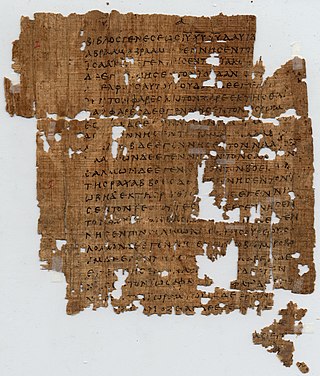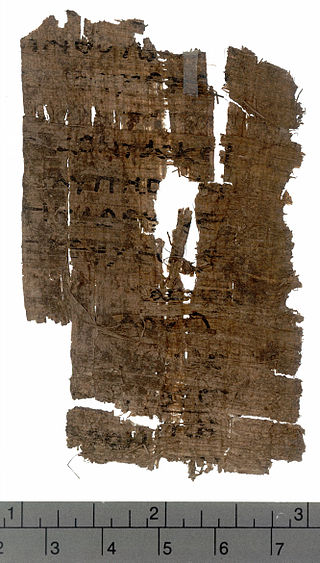Related Research Articles

The League of Corinth, also referred to as the Hellenic League, was a federation of Greek states created by Philip II in 338–337 BC. The League was created in order to unify Greek military forces under Macedonian leadership (hegemony) in their combined conquest of the Persian Achaemenid Empire.
The Greek language underwent pronunciation changes during the Koine Greek period, from about 300 BC to 400 AD. At the beginning of the period, the pronunciation was close to Classical Greek, while at the end it was almost identical to Modern Greek.

Papyrus 1 designated by "𝔓1", "ε 01 ", is an early Greek copy of a papyrus manuscript of one chapter of the Gospel of Matthew dating palaeographically to the early 3rd century. It was discovered in Oxyrhynchus, Egypt. It is currently housed at the University of Pennsylvania Museum.
In 359, the Roman Emperor Constantius II requested a church council, at Constantinople, of both the eastern and western bishops, to resolve the split at the Council of Seleucia. According to Socrates Scholasticus, only about 50 of the Eastern bishops, and an unspecified number of the western ones, actually attended.
Alexamenus of Teos was one of the potential inventors of Greek literary genre of prose dialogue. Also known as Alexamenus of Tenos or Alexamenus of Styra, the only surviving news about him have been handed down, centuries later, by three sources: Athenaeus of Naucratis, Diogenes Laërtius and a papyrus from Oxyrhynchus.

Papyrus 69 is a small fragment dating to the 3rd century. Scholars have debated whether its text is a witness to the Gospel of Marcion or the canonical Gospel of Luke.

Papyrus 6, designated by 𝔓6 or by ε 021, is a fragmentary early copy of the New Testament in Greek and Coptic (Akhmimic). It is a papyrus manuscript of the Gospel of John that has been dated paleographically to the 4th century. The manuscript also contains text of the First Epistle of Clement, which is treated as a canonical book of the New Testament by the Coptic Church. The major part of the codex is lost.
Papyrus 19, signed by 𝔓19, is an early copy of the New Testament in Greek. The manuscript paleographically has been assigned to the 4th or 5th century.

Papyrus 49 (Gregory-Aland), designated by 𝔓49, is an early copy of the New Testament in Greek. It is a papyrus manuscript of the Epistle to the Ephesians, surviving in a fragmentary condition. The manuscript has been palaeographically assigned to the 3rd century. It was probably a part of the same manuscript as Papyrus 65. It came from Egypt and was purchased for the Yale University Library. Textually it is close to the Codex Sinaiticus and Codex Vaticanus. The text of the manuscript has been published several times.

Papyrus 63, designated by 𝔓63, is a copy of the New Testament in Greek. It is a papyrus manuscript of the Gospel of John. The surviving text of John are verses 3:14-18; 4:9-10. The manuscript paleographically had been assigned to the 4th century.

Papyrus 98, designated by 𝔓98, is an early copy of the New Testament in Greek. It is a papyrus manuscript of the Book of Revelation. The manuscript palaeographically had been assigned to years 150–250.

Papyrus 100, designated by siglum 𝔓100, is an early copy of the New Testament in Greek. It is a papyrus manuscript of the Epistle of James. The surviving texts of James are verses 3:13-4:4; 4:9-5:1, they are in a fragmentary condition. The manuscript has been assigned paleographically to the late 3rd century, or early 4th century.

Papyrus 123, designated by 𝔓123, is an early copy of the New Testament in Greek. It is a papyrus manuscript of the First Epistle to the Corinthians.
Textual variants in the New Testament manuscripts arise when a copyist makes deliberate or inadvertent alterations to the text that is being reproduced. Textual criticism of the New Testament has included study of its textual variants.
The Claremont Profile Method is a method for classifying ancient manuscripts of the Bible. It was elaborated by Ernest Cadman Colwell and his students. Professor Frederik Wisse attempted to establish an accurate and rapid procedure for the classification of the manuscript evidence of any ancient text with large manuscript attestation, and to present an adequate basis for the selection of balanced representatives of the whole tradition. The work of Wisse is limited only to three chapters in Luke: 1, 10, and 20.

Minuscule 545, ε 511, is a Greek minuscule manuscript of the New Testament, on paper. It is dated by a colophon to the year 1430. Scrivener labeled it by number 558. It is housed at the University of Michigan. It has marginalia.
Codex Sinaiticus and Codex Vaticanus, two of the great uncial codices, representatives of the Alexandrian text-type, are considered excellent manuscript witnesses of the text of the New Testament. Most critical editions of the Greek New Testament give precedence to these two chief uncial manuscripts, and the majority of translations are based on their text. Nevertheless, there are many differences between these two manuscripts. A recent scientific comparative study of interest published on these two Alexandrian codices is "The Relationship between Vaticanus & Sinaiticus and the Majority Text in Galatians" by Dr. Graham G. Thomason and "THE SIGNIFICANCE OF SPLIT TEXT-TYPES FOR THE RECOVERY OF THE ORIGINAL TEXT OF THE GREEK NEW TESTAMENT" by Dr LESLIE McFALL - both are freely made available on the internet. Historically, the true character of these two Alexandrian manuscripts was quickly and thoroughly challenged by Dean John William Burgon's exhaustive analysis: "It is in fact easier to find two consecutive verses in which these two MSS differ the one from the other, than two consecutive verses in which they entirely agree."

Textual variants in the Gospel of Matthew are the subject of the study called textual criticism of the New Testament. Textual variants in manuscripts arise when a copyist makes deliberate or inadvertent alterations to a text that is being reproduced. An abbreviated list of textual variants in this particular book is given in this article below.

Papyrus 128, designated by 𝔓128, is a copy of a small part of the New Testament in Greek. It is a papyrus manuscript of the Gospel of John, containing verses 9:3-4; 12:16-18. The manuscript paleographically has been assigned to the 6th or 7th century.
Textual variants in the Gospel of Luke are the subject of the study called textual criticism of the New Testament. Textual variants in manuscripts arise when a copyist makes deliberate or inadvertent alterations to a text that is being reproduced. An abbreviated list of textual variants in this particular book is given in this article below.
References
- 1 2 3 4 B.W. Griffin and L.H. Blumell, The Oxyrhynchus Papyri, vol. 85, no. 5478, Egypt Exploration Society: London, England, 2020.
- ↑ "Liste Handschriften". Münster: Institute for New Testament Textual Research. Retrieved 3 September 2023.
- ↑ "Logos Bible Software and the Society of Biblical Literature are pleased to announce the release of a new, critically edited Greek New Testament". Bellingham, WA: Logos Bible Software. Retrieved 3 September 2023.